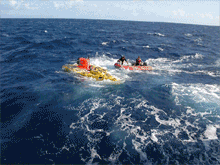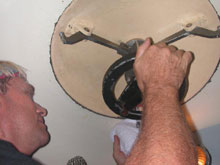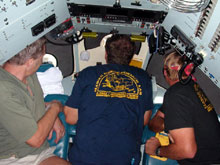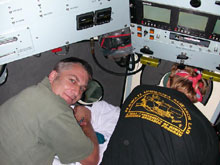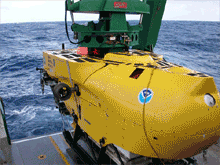
Pisces V is deployed off the back deck of the KoK. The A frame lifts the sub off the deck and lowers it into the water, where swimmers detach the tail line so that the sub is free to make its ascent to one of the Kermadec Arc submarine volcanoes.
![]() Click
image to view a slide show.
Click
image to view a slide show.
Pisces V is recovered from the waters of the SW Pacific after a successful dive on a Kermadec Arc submarine volcano. Swimmers attach the tail line and the life line to the A frame before the sub can be lifted back onto the deck of the ship.
Deployment and Recovery of the Pisces submersibles
April 14, 2005
Bill Chadwick
Oregon State University
NOAA Vents Program
![]() Pisces
V back deck deployment from the KoK (Quicktime, 2 Mb.)
Pisces
V back deck deployment from the KoK (Quicktime, 2 Mb.)
![]() Features
on the Pisces V Submersible (Quicktime, 1.8 Mb.)
Features
on the Pisces V Submersible (Quicktime, 1.8 Mb.)
![]() Recovery
of the Pisces V Submersible (Quicktime, 1.8 Mb.)
Recovery
of the Pisces V Submersible (Quicktime, 1.8 Mb.)
Getting a 14 ton submarine with 3 people on board in and out of the water safely is no simple feat. But the crew of the K-o-K perform this minor miracle every dive day in a well-orchestrated sequence that takes place remarkably smoothly and quickly. Each dive day begins with an evaluation of the weather and sea conditions by the captain and the operations director. If the conditions are suitable, the pilot and observers climb into the sub through the top hatch, then the pilot firmly closes the hatch from the inside. Next a small boat with two swimmers is launched over the side of the ship to help with the deployment.
The tie-downs are removed from the sub and it is lifted off the deck by the large A-frame on the stern of the ship. The A-frame then pivots and lowers the sub into the water on a heavy lift line. Depending on the conditions, this stage can be a bit exciting for the people in the sub. The lift line detaches as it is slacked, but the sub is still attached to the ship by a tail line, and as the ship drives forward the sub slowly trails aft. At this point, the small boat comes over to the sub and the swimmers detach the tail line. Now the sub is ready to flood its soft ballast tanks and start its decent to the seafloor. All that's left for the ship is to recover the small boat and the swimmers. Constant radio communication is maintained between the captain on the bridge, the launch director on the stern, and the pilot in the sub. The whole sequence only takes about 10 minutes from start to finish.
The sub is usually launched each dive day at 8am and is recovered by 5pm. Recovery of the sub at the end of a dive is essentially the same as the launch but in reverse, only the swimmers have to attach the tail line and the lift line before the sub can be lifted back onto the deck of the ship. Once safely on deck, the sub is tied down, the hatch is opened, and the observers emerge from their trip to another world, complete with physical samples, video, digital images, and the experienced of a lifetime.
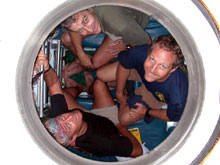
Chief Pilot Terry Kerby (lower left)looks up through the hatch from inside the Pisces V submersible, joined by Cornel de Ronde (top center) and Steve Price (right). Click image for larger view.
Diving inside Pisces V
April 14, 2005
Cornel E.J. de Ronde
Geologist
Institute of Geological & Nuclear Sciences (GNS)
Lower Hutt, New Zealand
If being in a small dark place for 8 hours at a stretch bothers you, then read no further. Because that is what happens when you go on a dive in the Pisces V submersible. But there is plenty to compensate for being in a cramped living space. The view outside the portholes is breathtaking. Pisces V can transport you to a wonderful, exciting and mostly foreign world.
It all starts when the hatch atop Pisces V is closed tight, and the submersible is lifted off the deck into the ocean below. Fortunately not much time elapses between being hoisted off the deck and the slow sink to the seafloor, as sometimes sitting on the surface in a swell can be unpleasant; you truly experience the feeling of being tossed about in a washing machine! The time taken to get to the bottom varies, but these volcanoes of the Kermadec arc that we are diving on have relatively shallow summits, so within 40 minutes and often much less, the bottom is seen by the sonar inside the submersible. The pilot slows the descent, and near the bottom drops the weights we used to get us down in the first place. We will then spend some time making sure the submersible is set up correctly for buoyancy, communicate with the surface to ascertain our position, then we're off!
Initial impressions of being in a deep diving submersible usually revolve around space, or the lack thereof. With three adults in a 7-foot diameter living space, it's cozy to say the least. Competition for leg space is at a premium. And if you are wondering, no, there is no toilet on board. But soon we are into the swing of things and have jobs to do, so everyone gets busy for the dive ahead. The pilot spends a lot of time on his knees peering out the forward-looking port hole. The co-pilot is to his right looking out another porthole slightly down and to the right, and the scientist observer looks out of a third porthole, down and to the left of the pilot. There is a bench type set-up so that you can lie on your stomach or side and crane your neck to see as wide a view angle as possible.
And what a view! Steep slopes of volcanic rock, some of which have tumbled from above, climb off in the distance, while elsewhere cliffs of pillow lavas rise impressively before us, like some hurdle we have to pass to get to the hot springs we have come to sample. As we maneuver our way up the slope and over the lava piles, we suddenly see the first signs of venting. Turbid water means there must be 'smoke' in the water, no doubt originating from the vents. Then we see films of microbial mats on the sediment surfaces, then we see them. Cracks and fissures in the seafloor with lots of hot water gushing out of them and mixing with the cold surrounding seawater. Bright yellow sulfur commonly marks the vent sites, and the animals are there in huge numbers. Piles of mussels fighting for a place on the rocks, crabs and starfish feeding on the mussels, tube worms and weird jelly fish and one irredescent green eel (or is it a seasnake?). The day goes by quickly and 8 hours after we entered the water we are on the way back to the surface. Every minute was spent mapping, taking video and still photographs, collecting water, gas, rock, mineral and animals samples. And we even managed to eat our packed lunch. Just another day for Pisces V, but an ever-lasting memory for those lucky enough to peer out the portholes…
Sign up for the Ocean Explorer E-mail Update List.



























